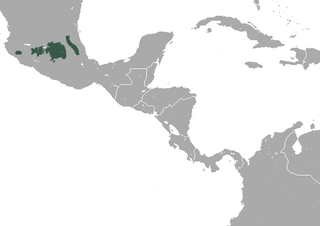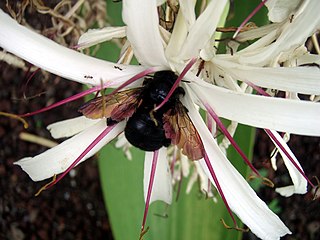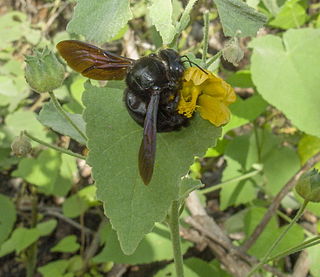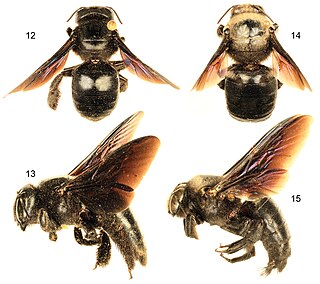
Carpenter bees are species in the genus Xylocopa of the subfamily Xylocopinae. The genus includes some 500 bees in 31 subgenera. The common name "carpenter bee" derives from their nesting behavior; nearly all species burrow into hard plant material such as dead wood or bamboo. The main exceptions are species in the subgenus Proxylocopa; they dig nesting tunnels in suitable soil.

Bee pollen is a ball or pellet of field-gathered flower pollen packed by worker honeybees, and used as the primary food source for the hive. It consists of simple sugars, protein, minerals and vitamins, fatty acids, and a small percentage of other components. Also called bee bread, or ambrosia, it is stored in brood cells, mixed with saliva, and sealed with a drop of honey. Bee pollen is harvested as food for humans and marketed as having various, but yet unproven, health benefits.

Xylocopa virginica, more commonly known as the eastern carpenter bee, extends through the eastern United States and into Canada. They nest in various types of wood and eat pollen and nectar. The eastern carpenter bee is similar to most other bee species in that it does not have a queen; in Xylocopa virginica, females are responsible for reproduction, foraging, and nest construction, though they may sometimes have help from their daughters. Xylocopa virginica is sympatric with Xylocopa micans in the southeastern United States.

Xylocopa violacea, the violet carpenter bee, is the common European species of carpenter bee, and one of the largest bees in Europe. It is also native to Asia.

Alticola is a genus of rodent in the family Cricetidae.

The silver mountain vole is a species of rodent in the family Cricetidae. They are distinguished by their silver-grey pelage, long vibrissae, rootless hypsodont molars and angular skull shape. Like many mammals of the Eurasian Steppe eco-region, they are well adapted to life in high altitudes, and can be found in mountain areas of Central and North Asia from the Chukchi Peninsula in the north-east to Kugitang Range in the west, and to Tibet and the Himalayas in the south.
The central Kashmir vole is a species of rodent in the family Cricetidae. It is found only in India and Pakistan.

Stolička's or Stoliczka's mountain vole is a species of rodent in the family Cricetidae. It is found in China, Pakistan, India and Nepal.
The flat-headed vole is a species of rodent in the family Cricetidae. It is found in China, Kazakhstan, Mongolia, and Russian Federation.
The Tuva silver vole is a species of rodent in the family Cricetidae. It is found in Mongolia and Russian Federation.

The Central Mexican broad-clawed shrew is a species of mammal in the family Soricidae. It is found in the highlands above 2000 m in the Mexican states of Colima, Hidalgo, Jalisco, Michoacán, Mexico, and Puebla, Morelos, and in the Mexican Federal District

The Cecidomyiinae are a subfamily of flies often called gall midges or gall gnats. Many are parasitoids or predacious as maggots.

The Lasiopteridi is a supertribe of flies from the family Cecidomyiidae. They are often called gall midges or gall gnats.

Xylocopa sonorina, the valley carpenter bee or Hawaiian carpenter bee, is a species of carpenter bee found from western Texas to northern California, and the eastern Pacific islands. Females are black while males are golden-brown with green eyes.

The California carpenter bee, Xylocopa californica, is a species of carpenter bee in the order Hymenoptera. It is native to western North America.
Malagasia is a monotypic genus of trees in the family Proteaceae. The sole species is Malagasia alticola, endemic to Madagascar.

Xylocopa darwini, the Galápagos carpenter bee, is one of only three species of bees found in the Galápagos Islands, to which it is endemic. This species is sexually dimorphic, is found on 75% of the largest islands, and is known for its complex behavior. As the only native bee, Xylocopa darwini serves as an important primary pollinator within the plant-pollinator network of the archipelago.

Xylocopa sulcatipes is a large Arabian carpenter bee. These multivoltine bees are known to take part in social nesting and cooperative nesting. These metasocial carpenter bees nest in thin dead branches. One or more cooperating females build many brood cells. They have been extensively studied in Saudi Arabia and Israel.

Xylocopa pubescens is a species of large carpenter bee. Females form nests by excavation with their mandibles, often in dead or soft wood. X. pubescens is commonly found in areas extending from India to Northeast and West Africa. It must reside in these warm climates because it requires a minimum ambient temperature of 18 degrees Celsius in order to forage.












